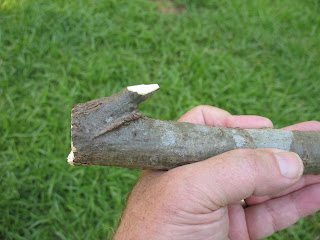
The grip and finger holds are made of brain-tanned leather. Pictured below: Grip with finger holds.

The dart hook on the end is cut out of elk antler and attached to the body with hide glue and sinew. Pictured below: Elk antler dart hook.

The rock weight on the atlatl is called a banner stone. It is attached with glue and sinew. The banner stone gives weight to the atlatl and imparts more energy to your throw. Pictured below: Banner stone.

My fancy dart is not much different from my improved survival dart. The main shaft is made of river cane which has been carefully straightened. The foreshaft is made of straightened huckleberry. Pictured below: Front of cane shaft and huckleberry foreshaft.

The point is about two and a half inches long and is knapped from flint. The point is attached with rawhide glue and deer sinew. Notice that the point has a rounded shoulder for easier removal from a game animal. Pictured below: Flint dart point.

This dart has three turkey feather fletchings attached with deer sinew, and the socket on the back of the dart has been reinforced with deer sinew to prevent splitting. Pictured below: Fletchings.

Next post will be how to use the atlatl and dart and a comparison of the atlatl and dart to the spear.


























